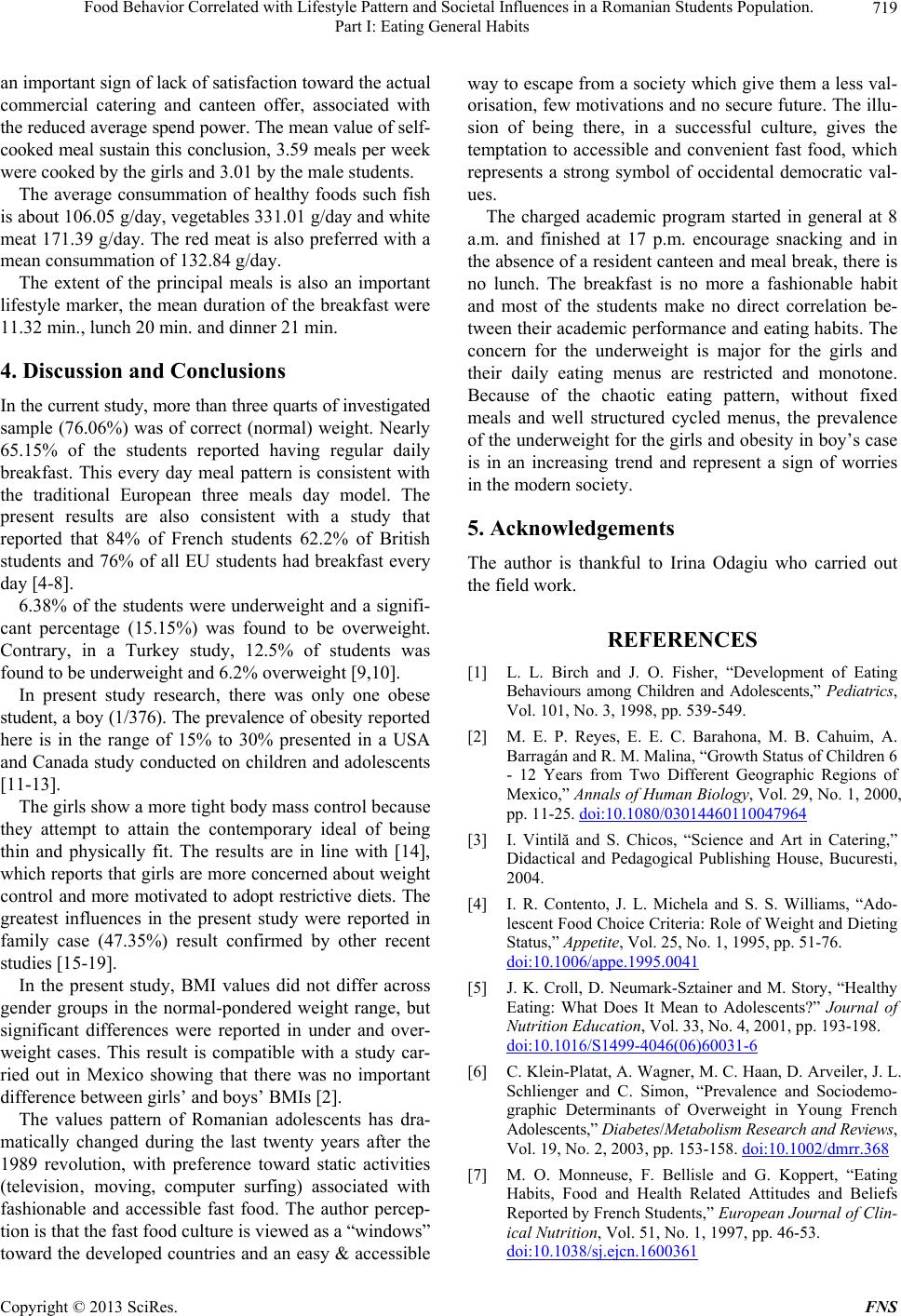
Food Behavior Correlated with Lifestyle Pattern and Societal Influences in a Romanian Students Population.
Part I: Eating General Habits
719
an important sign of lack of satisfaction toward the actual
commercial catering and canteen offer, associated with
the reduced average spend power. The mean value of self-
cooked meal sustain this conclusion, 3.59 meals per week
were cooked by the girls and 3.01 by the male students.
The average consummation of healthy foods such fish
is about 106.05 g/day, vegetables 331.01 g/day and white
meat 171.39 g/day. The red meat is also preferred with a
mean consummation of 132.84 g/day.
The extent of the principal meals is also an important
lifestyle marker, the mean duration of the breakfast were
11.32 min., lunch 20 min. and dinner 21 min.
4. Discussion and Conclusions
In the current study, more than three quarts of investigated
sample (76.06%) was of correct (normal) weight. Nearly
65.15% of the students reported having regular daily
breakfast. This every day meal pattern is consistent with
the traditional European three meals day model. The
present results are also consistent with a study that
reported that 84% of French students 62.2% of British
students and 76% of all EU students had breakfast every
day [4-8].
6.38% of the students were underweight and a signifi-
cant percentage (15.15%) was found to be overweight.
Contrary, in a Turkey study, 12.5% of students was
found to be underweight and 6.2% overweight [9,10].
In present study research, there was only one obese
student, a boy (1/376). The prevalence of obesity reported
here is in the range of 15% to 30% presented in a USA
and Canada study conducted on children and adolescents
[11-13].
The girls show a more tight body mass control because
they attempt to attain the contemporary ideal of being
thin and physically fit. The results are in line with [14],
which reports that girls are more concerned about weight
control and more motivated to adopt restrictive diets. The
greatest influences in the present study were reported in
family case (47.35%) result confirmed by other recent
studies [15-19].
In the present study, BMI values did not differ across
gender groups in the normal-pondered weight range, but
significant differences were reported in under and over-
weight cases. This result is compatible with a study car-
ried out in Mexico showing that there was no important
difference between girls’ and boys’ BMIs [2].
The values pattern of Romanian adolescents has dra-
matically changed during the last twenty years after the
1989 revolution, with preference toward static activities
(television‚ moving, computer surfing) associated with
fashionable and accessible fast food. The author percep-
tion is that the fast food culture is viewed as a “windows”
toward the developed countries and an easy & accessible
way to escape from a society which give them a less val-
orisation, few motivations and no secure future. The illu-
sion of being there, in a successful culture, gives the
temptation to accessible and convenient fast food, which
represents a strong symbol of occidental democratic val-
ues.
The charged academic program started in general at 8
a.m. and finished at 17 p.m. encourage snacking and in
the absence of a resident canteen and meal break, there is
no lunch. The breakfast is no more a fashionable habit
and most of the students make no direct correlation be-
tween their academic performance and eating habits. The
concern for the underweight is major for the girls and
their daily eating menus are restricted and monotone.
Because of the chaotic eating pattern, without fixed
meals and well structured cycled menus, the prevalence
of the underweight for the girls and obesity in boy’s case
is in an increasing trend and represent a sign of worries
in the modern society.
5. Acknowledgements
The author is thankful to Irina Odagiu who carried out
the field work.
REFERENCES
[1] L. L. Birch and J. O. Fisher, “Development of Eating
Behaviours among Children and Adolescents,” Pediatrics,
Vol. 101, No. 3, 1998, pp. 539-549.
[2] M. E. P. Reyes, E. E. C. Barahona, M. B. Cahuim, A.
Barragán and R. M. Malina, “Growth Status of Children 6
- 12 Years from Two Different Geographic Regions of
Mexico,” Annals of Human Biology, Vol. 29, No. 1, 2000,
pp. 11-25. doi:10.1080/03014460110047964
[3] I. Vintilă and S. Chicos, “Science and Art in Catering,”
Didactical and Pedagogical Publishing House, Bucuresti,
2004.
[4] I. R. Contento, J. L. Michela and S. S. Williams, “Ado-
lescent Food Choice Criteria: Role of Weight and Dieting
Status,” Appetite, Vol. 25, No. 1, 1995, pp. 51-76.
doi:10.1006/appe.1995.0041
[5] J. K. Croll, D. Neumark-Sztainer and M. Story, “Healthy
Eating: What Does It Mean to Adolescents?” Journal of
Nutrition Education, Vol. 33, No. 4, 2001, pp. 193-198.
doi:10.1016/S1499-4046(06)60031-6
[6] C. Klein-Platat, A. Wagner, M. C. Haan, D. Arveiler, J. L.
Schlienger and C. Simon, “Prevalence and Sociodemo-
graphic Determinants of Overweight in Young French
Adolescents,” Diabetes/Metabolism Research and Reviews,
Vol. 19, No. 2, 2003, pp. 153-158. doi:10.1002/dmrr.368
[7] M. O. Monneuse, F. Bellisle and G. Koppert, “Eating
Habits, Food and Health Related Attitudes and Beliefs
Reported by French Students,” European Journal of Clin-
ical Nutrition, Vol. 51, No. 1, 1997, pp. 46-53.
doi:10.1038/sj.ejcn.1600361
Copyright © 2013 SciRes. FNS